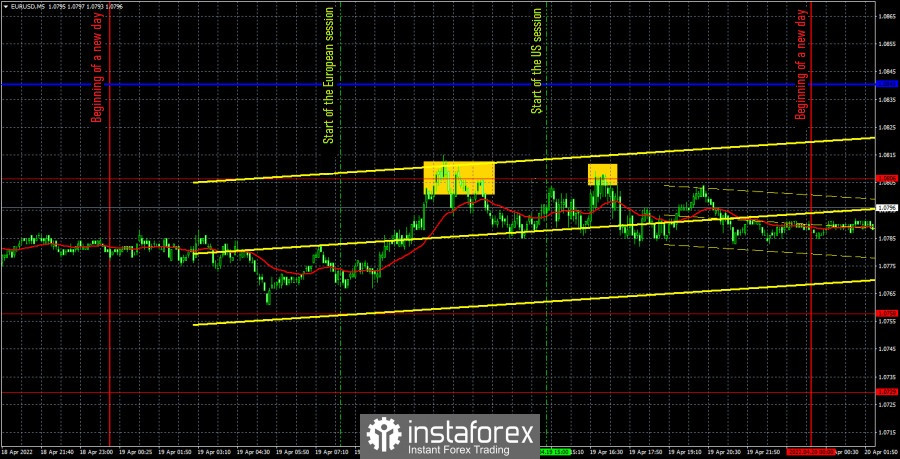

The EUR/USD pair continued an unintelligible movement on Tuesday, most similar to a flat. The pair made an attempt to start a round of upward correction during the day, but all the bulls' attempts ended very quickly, near the extreme level of 1.0806. Two rebounds from this level put an end to the euro's attempt to grow at least a little. Thus, it continues to remain very close to its 15-month lows and so far cannot find any clear reason to start at least a tangible correction. Yesterday, there was not a single important event in the United States or in the European Union. The "second phase" of the military conflict has begun in Ukraine, which now covers the entire Donbas. It is expected that active fighting will be conducted for several weeks, after which there will be a relaxation of tension. In many ways, the outcome of the entire conflict between Ukraine and Russia will depend on the outcome of the "battle for Donbas".
There were only two trading signals on Tuesday. The pair bounced twice from the 1.0806 level, thus forming two sell signals. Both times the price was able to go down about 10 points. That's how much traders could earn on a short position yesterday. It was impossible to get a loss, since the pair could not settle above the level of 1.0806. Accordingly, none of the sell signals were canceled.
COT report:
The latest Commitment of Traders (COT) reports are more and more discouraging... because the big players continue to build up long positions in the euro currency! During the reporting week, the number of long positions increased by another 10,800, and the number of shorts from the "non-commercial" group decreased by 1,000. Thus, the net position increased by 12,000 contracts. This means that the bullish mood has intensified. It is bullish, since the total number of long positions now exceeds the total number of short positions for non-commercial traders by 40,000!!! The green line of the first indicator in the chart above clearly signals that the mood of professional players has been bullish in the last three and a half months. Accordingly, the paradox lies in the fact that the mood of traders is bullish, but the euro continues to fall almost non-stop, which is also clearly seen in the chart above. We have already explained in previous articles that this effect is achieved by a higher demand for the US dollar. The demand for the dollar is higher than the demand for the euro, which is why the dollar is growing in tandem with the euro. Based on this conclusion, the data of the COT reports on the euro now do not make it possible to predict the further movement of the pair. They are, one might say, meaningless. However, if the demand for the euro currency also begins to fall among professional players, this may lead to an even greater fall in the euro exchange rate, since the demand for the dollar is likely to remain high due to complex geopolitics and macroeconomics.
We recommend to familiarize yourself with:Overview of the EUR/USD pair. April 20. The "Ukrainian crisis", in which the whole world can drown.
Overview of the GBP/USD pair. April 20. James Bullard: there is no time to argue, we need to raise the bid!
Forecast and trading signals for GBP/USD on April 20. Detailed analysis of the movement of the pair and trading transactions.
EUR/USD 1HIt is even better to see how indistinct the movement is now on the hourly timeframe. Especially in the last few days, which the pair spent between the levels of 1.0758 and 1.0820. At the same time, there is no doubt about the downward trend now. The pair cannot even correct normally, and there is still no trend line or trend channel. The most non-standard situation with almost one hundred percent probability of further fall of the pair. We allocate the following levels for trading on Wednesday – 1.0729, 1.0758 (support level), 1.0806, 1.0924 (support level), 1.0938, 1.1036, as well as the Senkou Span B (1.0931) and Kijun-sen (1.0840) lines. The lines of the Ichimoku indicator can move during the day, which should be taken into account when determining trading signals. There are also secondary support and resistance levels, but no signals will be formed near them. Signals can be "bounces" and "breakthrough" levels - extremes and lines. Do not forget about placing a Stop Loss order at breakeven if the price went in the right direction of 15 points. This will protect you against possible losses if the signal turns out to be false. A report on industrial production will be released in the European Union on April 20, and in the United States – a review of the Federal Reserve "Beige book". Both of these reports have almost no chance of provoking a market reaction. Most likely, we are waiting for another flat day or a day with indistinct and unpredictable movements. Nevertheless, the downward trend persists, so, of course, if we do consider options for opening positions, then it would be for selling.
Explanations for the chart:Support and Resistance Levels are the levels that serve as targets when buying or selling the pair. You can place Take Profit near these levels.
Kijun-sen and Senkou Span B lines are lines of the Ichimoku indicator transferred to the hourly timeframe from the 4-hour one.
Support and resistance areas are areas from which the price has repeatedly rebounded off.
Yellow lines are trend lines, trend channels and any other technical patterns.
Indicator 1 on the COT charts is the size of the net position of each category of traders.
Indicator 2 on the COT charts is the size of the net position for the non-commercial group.